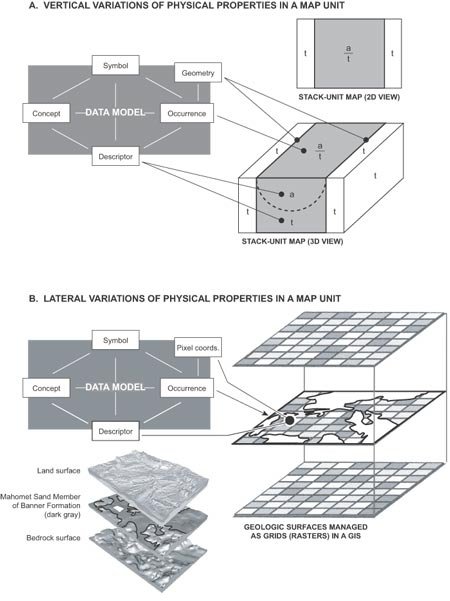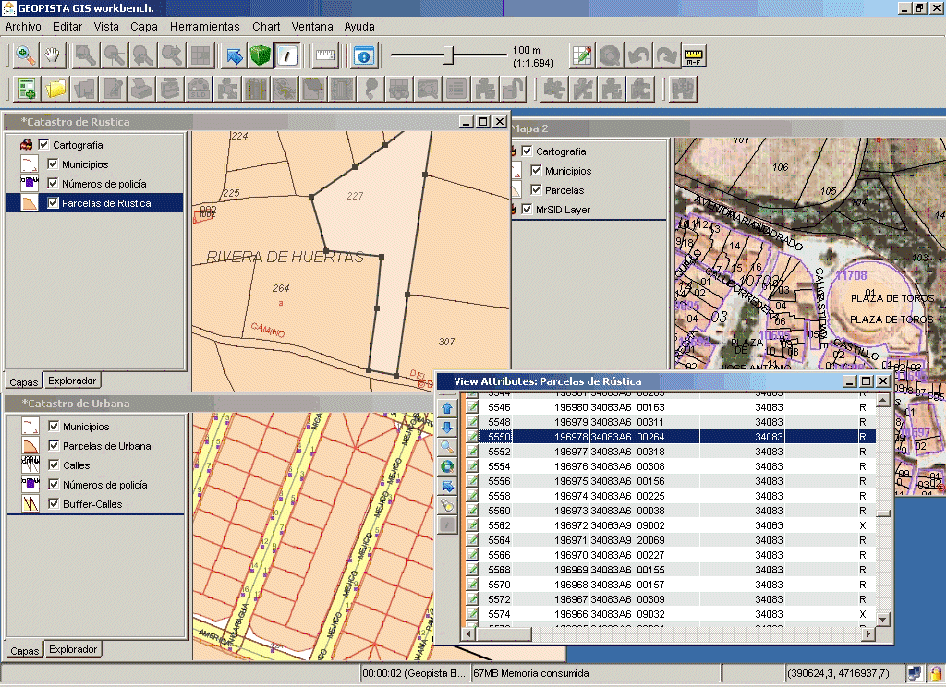Comparative Use of Law Enforcement Application of GIS Technology in Four Countries: the United States, England, India, and Canada
For those of you that haven't been exposed to GIS technology, it is pretty cool.
GIS or Geographic information systems can be used (often in real time) to analyze and display information over maps. Informational overlays can be added, filtered, and updated with immediate data.

I went to a conference of first responders the year before last, and one of the seminars was on the use of GIS in reacting to disaster situations. The presenter was from a regional agency's GIS team that had the permission to repsond to other areas within Texas to assist with their GIS activity. He gave us examples of GIS use in the Dallas Ebola response and in cleaning up debris from the Space Shuttle Columbia breakup.
This report was originally published on my blog in slightly different form on March 26, 2016 at http://gradschoolfool.blogspot.com/2016/03/comparative-use-of-law-enforcement.html. This material may be shared under Creative Commons auspices.
This summary paper will highlight the major attributes of police use of GIS technology in four countries; the United States, England, India, and Canada. The characteristics for each country that this paper examines are the following:
Technological development in these regions.
- Existent GIS systems
- Uses of GIS systems beyond law enforcement applications
- The effect that the 9/11 attacks had on public safety measures
- A brief overview of law enforcement
- The future of law enforcement
The United States
Technology advances in the United States have been almost been as rapidly integrated into law enforcement techniques as they have been developed into public use. The Johnson administrations commitment to use Federal resources to assists local agencies in using new technology. GIS systems have been part of the American heritage to adapt to new technology.” Law enforcement officers and civilian crime analysts have been mapping crime virtually since the time that police agencies were established--through the use of push pins and a paper map.
The diffusion of GIS into crime analysis has been a slow process primarily because of cost (both hardware and software) and complexity” (Groff & La Vigne, 1998, p. 2) “In the early 1980s, client server technology made geographic information systems more accessible, and this enabled a number of police departments to experiment with crime mapping in their everyday work” (Santos, 2013, p. 11).
The United States criminal justice system is a federal system with many different jurisdictions that use different GIS applications. Leipnik & Albert discuss several case studies from across the country in their book, GIS in Law Enforcement: Implementation Issues and Case Studies.
GIS systems can be used for many applications beyond policing. Missing children, public health monitoring, and disaster response are just three examples of GIS application. Such uses have included the search for debris from the space shuttle Columbia disaster in 2003 (Allen, 2015).
In the reorganization and reaffirmation of the American security community in response to the 9/11 attacks, the Department of Homeland Security recognized the key part technology plays in securing the nation. GIS capabilities are included in this vision, as the “DHS Office of Grants and Training recognizes the important contribution that geospatial information and technology plays in strengthening our Nation’s security posture” (“FY 2007 Homeland Security”, 2007, p. 1).
Law enforcement in the United States, as stated, is multi-jurisdictional in nature. The two major considerations in the American criminal justice system are protecting the community and adhering to due process considerations. American policing has been at the forefront of research in underlying crimogenic causes, procedural policing, and technological assistance to law enforcement since the days of Vollmer.
It is in the technological field that he future of policing lies, as “In this technological era, law enforcement has had to evolve to fulfill its mandate of contributing to overall public security” (Grant & Terry, 2005, p. 324).
England
Although England may not have the wide technological base as the United States to draw upon, the basic techniques of crime mapping were being studied in England as early as the 1850's (Canter, 2000, p.3)
England has implemented GIS systems rapidly. In 1999, 44% of English police stations had crime mapping facilities (Griffin, 2001, p.11). By 2005, 90% of police units in England used GIS applications fro law enforcement purposes (Weir & Bangs, 2007, p. 3).
One way in which the English have used GIS systems outside of law enforcement is in highway planning, and is “presently using GIS information largely around highlighting areas in need of improvement” (Merritt, 2015, para. 6).
9/11 played a part in the development of London's “Ring of Steel”; however, it has been seen that GIS/CCTV systems can not prevent terror attacks simply by being in place.
Law enforcement in the United Kingdom is based upon Peelian Principles (Boyd & Skelton, 2012, p. 6). A major difference between American police and English police is that Americans swear their oath of office to defend the Constitution while English officers swear loyalty to the Crown
According to Boyd and Skelton (2012, p. 48), the following priorities are crucial to the future of English policing:
- A relentless focus on the prevention of crime and disorder
- Policing to be delivered locally
- The public to be encouraged to play a full part in the fight against crime
- Outcome-oriented PCCs who are fully engaged with their policing partners

India
Although India is an underdeveloped nation, it has a large demographic base which includes technological savvy. “India has long been a leader in using modern spatial technologies and started its tryst with satellite images and GIS in the 1980s “ (“India: A vision”, 2013, para. 1)
Griffin questioned the ability of police in Bombay to be able to access such systems for police work (2001, p. 2). However, several Indian municipalities have implemented GIS systems. “The plan to introduce GIS/GPS in Mumbai police was mooted in 2000.” (“Be prepared for”. 2006, p.3) and “officials of the special branch...are being trained in this technology. (“Kerala police plan”, 2010, para. 3).
GIS systems are not in use commonly throughout India, in “spite of the wide usage of GIS as a technology, the potential of GIS has not yet been fully exploited for decision support by planners, stakeholders, decision makers, (“India: A vision”, 2013, para. 6)
In contrast to the United States, India has long been a target of Islamist terror. A short list of attacks includes the 1993 Bombay bombing, a series of kidnappings in 1994 and 1995, the 1998 massacres in Chamba and Prankote, and the 2001 Chalwalkote massacre. India has retained it's anti-terror policy.
Like the United States, India is a federal governmental system, resulting in many jurisdictions. A major difference is that senior police officials in many different police agencies all belong to the Indian Police Service, a centralized agency.
Police in India must overcome political interference before moving to procedural or technological goals. There are “many instances where the statutory duties of the police havebeen interfered with by the political players” (Dutta & Baruah, 2008, p.122)
Canada
Canada has the lowest population of the four countries to draw upon for resources, but a common language and common border with the United States provides Canada and it's police forces with convenient access to technological services.
Several major cities in Canada use GIS systems Vancouver PD uses GIS application for their Intelligence Led Policing project (“Vancouver police focuses”, 2011, para. 1). The Toronto Police Service was an “early adopter of geographic information system technology” in the 1990's, (Marshall, 2008, para. 1).
Canada also uses GIS applications for other than police work. For example, “the Department used GIS to support pre-planning activities and actual operations during the 2010 Vancouver Winter Games (“Vancouver police focuses, 2011, para. 3).
The attacks on 9/11 bought a higher focus on security for the United States/Canada border (Kislenko, 2012, p. 310).
Canada, like the United States and India, uses a federal governing system, with police agencies at each level and local jurisdictions.
Canadian police must look forward to an era of “increasingly scarce public resources”, and must become more efficient to mitigate that lack of resources (Di Matteo, 2014, p. 2).
Image Sources, In Order
Although some of these are not in English, the saying that a picture is worth a 1000 words comes into play here!
- By David R. Soller1 and Thomas M. Berg [Public domain], via Wikimedia Commons
- T.Nijeholt at nl.wikibooks [GFDL (http://www.gnu.org/copyleft/fdl.html) or CC-BY-SA-3.0 (http://creativecommons.org/licenses/by-sa/3.0/)], via Wikimedia Commons
- By CJFuertes (Own work) [GFDL (http://www.gnu.org/copyleft/fdl.html) or CC BY-SA 3.0 (http://creativecommons.org/licenses/by-sa/3.0)], via Wikimedia Commons
- T.Nijeholt at nl.wikibooks [GFDL (http://www.gnu.org/copyleft/fdl.html) or CC-BY-SA-3.0 (http://creativecommons.org/licenses/by-sa/3.0/)], via Wikimedia Commons
References
Allen, D. (2015, May).Geographic information systems mapping: Response, availability, and training. Presented at the Texas 2015 Emergency Management Conference. San Antonio, Texas.
Be prepared for quick response from police. (2006, January 29). The Times of India. Retrieved June 15, 2015 from http://timesofindia.indiatimes.com/city/mumbai/
Be-prepared-for-quick-response-from-police/articleshow/1391044.cms
Boyd, E. and Skelton, D. (2012) Policing 2020: What kind of police service do we want in 2020? Policy Exchange. Retrieved June 16, 2015 from http://www.policyexchange.org.uk/images/publications/policing%202020.pdf
Canter, P. (2000). Analyzing crime patterns: Frontiers of practice. In Using a Geographic Information System for Tactical Crime Analysis (pp. 3–11). Thousand Oaks, CA: SAGE Publications, Inc. Retrieved June 15, 2015 from http://faculty.uml.edu/apattavina/44.594/Tactical%20Crime%20Analysis.pdf
Dutta, M. and Baruah, M. (2008) Policing the nation in the 21st century : An appraisal of the proposed reforms. NUJS Law Review. Retrieved June 16, 2015 from http://www.manupatra.co.in/newsline/articles/Upload/9D7B024D-7F33- 4379-A512-F3252B9A90CA.pdf
Grant, H., & Terry, K. (2005). Advances in policing—new technologies for crime analysis. In Law enforcement in the 21st century. Boston, MA: Pearson.
FY 2007 Homeland security grant program supplemental resource: Geospatial guidance. (2007). Department of Homeland Security.
Griffin, J. (2001). International crime mapping: Caveats and considerations. Crime Mapping News, 3 (1). Retrieved June 15, 2015 from http://www.policefoundation.org/sites/pftest1.drupalgardens.com/files/
Vol3Issue1.pdf
Groff, E. R., & La Vigne, N. G. (1998). The use of geographic information systems (GIS) for state and local crime analysis. In conference of European statisticians, Ottawa (pp. 5–7). Citeseer. Retrieved June 15, 2015 from http://citeseerx.ist.psu.edu/viewdoc/download? doi=10.1.1.113.7957&rep=rep1&type=pdf
India: A vision for National GIS. (2013, Fall). ARCnews. Retrieved June 15, 2015 from http:// www.esri.com/esri-news/arcnews/fall13articles/india-a-vision-for-national-gis
Kerala police plan GIS-based crime mapping. (2010, July 1). Geospatial World. Retrieved June 15, 2015 from http://geospatialworld.net/News/View.aspx?ID=17886_Article
Kislenko, A. (2012). Guarding the border: Intelligence and law enforcement in Canada’s immigration system. In The Oxford Handbook of National Security Intelligence. USA. Oxford University Press.
Leipnik, M. R., & Albert, D. P. (2003). GIS in Law Enforcement: Implementation Issues and Case Studies. CRC Press.
Marshall, P. (2008, May 2). Toronto police struggle with GIS' success. GCN. Retrieved June 15, 2015 from http://gcn.com/articles/2008/05/02/toronto-police-struggle-with-gis- success.aspx
Merritt, N. (2015, May 19). Highways England mulls GIS expansion potential. Government Computing. Retrieved June 16, 2015 from http://central- government.governmentcomputing.com/news/highways-england-mulls-gis- expansion-potential-4580951
Santos, R. (2013). Crime analysis with crime mapping (Third edition).Thousand Oaks, CA. SAGE Publications, Inc.
Vancouver police focuses on Intelligence-Led Policing for proactive crime reduction. (2011, November 8). GISCafe. Retrieved Retrieved June 15, 2015 from http://www10.giscafe.com/nbc/articles/view_article.php? section=CorpNews&articleid=1028370
Weir, R., & Bangs, M. (2007). The use of geographic information systems by crime analysts in England and Wales. [London]: Home Office, Research, Development and Statistics Directorate. Retrieved June 15, 2015 from http://www.homeoffice.gov.uk/rds/pdfs07/rdsolr0307.pdf
If you start to follow me, please let me know so that I can return your follow!



I have no idea what this is, so I upvoted and resteemed just to make myself look smarter!
LOL, thanks!
do you remember the clear plastic layovers over maps where op orders were drawn out?
this is the same thing done on computers, with a LOT more complexity and options. One of the options is to update that battleplan immediately with new info as it comes in
other things that could be done would be to analyze the areas that had the most casualties to move the mash units over, or to compute ammo use to start bringing in more ammo even before the unit requests it!
Jeez...I feel cheated! All I ever got was a plastic covered strip map and whatever we could carry!
you got the Saigon 7-11 map.
Arrows point to North Korea, Russia, Cuba, and the Big PX.
One vaguely drawn in circle says "watch out for mines!"...but there's a grease spot over half of it
The bottom half of the map has been pasted over by a RAND study;>
Actually, RAND did good work back then, and had some pretty good studies on everything until about 2 years ago, and now it seems like every RAND study is a leftist/globalist propaganda rag
Whoever or WHATEVER can predict the future , controls the world.
Steemit Blockchain Will Be The Central Cortex Of The Global Quantum A.I.'s Brain - The Sentient World Simulaion, for predicting the future.
STEEMIT PROCESSES MORE DATA THAN ALL THE OTHER BLOCKCHAIN CRYPTO-CURRENCIES COMBINED.
All the quantum computers of all the worlds biggests corporation are interlinked and working to this end.
Any one with even half a brain knows that blockchain technology is not going away. It's here to stay!
Why? Because EVERYTHING... every piece of data and every piece of edge computing hardware is soon to be tied (chained) into the blockchain matrix in the cloud. Including EVERY product, service, creative and recreational activity that we do.
Using 5g technology and cheap telemetric printed circuit tattoos (like barcodes on steroids) able to sense, process and transmit data, will be in EVERYTHING and EVERYONE.
We will all become part of the Sentient World Simulation (SWS) as described in the popular Purdue University white paper on this subject, It's already up & running right under your noses as you read this blog post. IT'S WATCHING YOU!!!
We each have a Global Quantum A.I. avatar following and recording our every move using our 'smart' phones, 'smart' appliances - TV's, game consoles, 'smart' fridges, 'smart' meters & 'smart' cookers, etc.
We each have our own virtual world avatar that simulates & mimics our character, in order to predict the future.
Whoever or WHATEVER can predict the future , controls the world... The Global Quantum A.I.
If they're watching me they must be bored (and not too smart)
This technology seems to be similar to Sentient World Simulation.
Wow, I just took a quick look at Sentient World Simulation.
GIS seems to be a portion of the Sentient World Simulation capability. It looks like Sentient World Simulation is so much more than that. AI predictions, a compilation of ALL data possible, combined with illegal data mining.
GIS is a tool. Sentient World Simulation looks like the extreme possible abuse of that tool.
I wonder if the Sentient World Simulation is programmed with my avatar shooting them the finger all the time?
definitely more to look at here!
http://www.krannert.purdue.edu/academics/mis/workshop/ac2_100606.pdf
https://en.wikipedia.org/wiki/Synthetic_Environment_for_Analysis_and_Simulations
https://www.corbettreport.com/sentient-world-simulation-meet-your-dod-clone/
LOL. No doubt, I've put some choice middle finger shaped wrenches in their machine. Nice work. I'll follow your content. Cheers
just sos I don't give you any false ideas here, I'm a minarchist, not an anarchist ;>
thanks for the follow and returned!